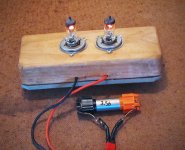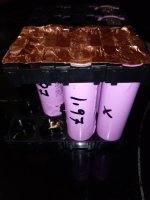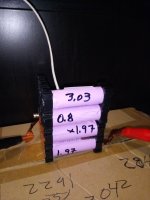eMark
100 kW
One question (with respect to 30Q) is: What is acceptable mild discharge? Maybe, he meant was self-discharge higher than normal, but not as high as a certain percentage of cells in a 30Q battery pack. Do you generally agree with BlueSeas previous post pasted below (i do) ...goatman said:no to 30Q fixing itself
This is especially true with the interconnecting of parallel and series bus bars giving a false impression that the individual cells in the p-groups are closer in voltage and mAh than the individual cells' actual resting voltage (when taken alone instead of linked together in a p-group).BlueSeas said:The observed phenomenon of high self discharge may be true for many cells, and further may go largely unreported. Especially if the charge process has an effective balancing routine to rebalance the pack.
That is generally true (e.g. MJ1/M36 cells), but not so true with 30Q being the one Li-ion cell most often reported as prone to "high" self-discharge. High enough so as to diminish a packs' effectiveness and the potential of an internal short in one of the p-groups. This is why i decided from the GetGo with my VRUZEND 10S3P to bottom balance the p-groups within a few mV of each other before straight charging the two sub-pack 5S3P paralleled p-groups within 10-15mV of each other using two 5S3P paralleled sub packs for bottom balancing with 2S-6S balance charger before straight charging.BlueSeas said:This self discharge isn't by itself in most cases isn't a reason to trash the pack...or even the cell. But does require some degree of balancing.
Because of the interconnected series and parallel bus bars it's difficult to know which p-group has a "bad" cell(s) with a not-so-smart BMS ... until the BMS finally cuts off power due to cell(s) failure. That might be one definition of a "bad" cell when the BMS cuts off power due to cell failure and not moderate self-discharge even though it's greater than what's considered normal self-discharge for a particular Li-ion cell chemistry or energy density.goatman said:if 1 cell is bad in a p-group it will take out the entire p-group, even the good cells.
Whereas as BlueSeas points out a cell with moderate self-discharge that's higher than normal for that cells' unique chemistry may still serve a useful pack purpose for many charge/discharge cycles until it finally poops out (fails), and the BMS shuts down the battery. A percentage of 30Q cells are apparently more problematic (high self-discharge) than are MJ1/M36 cells (5 to 10Ah) or another brand name high energy cell (15 to 20Ah).
That 12hr "balancing charge" showed that it was NOT the 3.44V cell (that one would think) that was the reason for a lengthy "balancing charge" (although it contributed), and still only a 2S pack voltage of 7.48V (3.74V per each 1S5P groupafter 12 hrs). That's only an increase of 1.16V using balance charging at 0.60 amps (.2C) for twelve hours. That justifies my reason for not using a BMS ... ineffective when it comes to top balancing the p-groups. It was the 2S3P 3.53V cell that failed before the 3.44V cell and reason why cells with high self-discharge dramatically slow down balance charging the lower the charge amperage (e.g. 0.60 amps) ...goatman said:when you built the 2s5p i thought it wouldve been a good test to see if doing the 0.6amp discharge/charge 4.2v/2.5v would be able to save a pack without disassembling it and replacing cells but you stopped early on the charge without completing the process because of length of time it was taking by having the 3.44v cell paralleled in the group it will be brought down by the self discharging cells
This failure of the 2S3P cell did not result in an internal short1S1P 2S1P
3.56 3.44
1S2P 2S2P
3.70 3.73
1S3P 2S3P
3.53 3.53 (damaged cell when pack was drained for only 2.58V bounce back after 24 hrs.
1S4P 2S4P
3.65 3.62
1S5P 2S5P
3.70 3.70
Isn't it generally assumed that the more cells in a p-group they tend to keep each other balanced with less stress on each individual cell in a p-group? If i would've built a 10S5P 30Q 141 VRUZEND battery pack it's my understanding that instead of nine cells showing higher than normal self-discharge (3.44V-3.70V) of the other 20 cells (3.75V-3.74V) and one other cell at 3.73V after five days.goatman said:why did you switch from 5s2p to 2s5p
Didn't use a HobbyKing charger. It's very similar to the iMAX B6 with ability to check p-groups' IR. It's like the B6 circuitry so you need to take at least 3 p-group readings as each one can vary by 2-4mΩ, then average them out or take the three lowest readings as suggested by another member (think it was Serious Sam).goatman said:your hobby charger would be able to do the test in less than half the time at 5s2p
Am running 4-5 more tests that i started yesterday evening. The purpose is to confirm at least in my mind that just because a 30Q cell leaks mAh doesn't mean it looses it's ability hold the same capacity as one of the other "good" twenty cells in the 10S3P 30Q 141 VRUZEND battery having the same number of charge/discharge cycles as the ten other cells showing higher self-discharge (3.73V to 3.44V from 1/5/21 to 1/15/21. The "good" twenty cells had the same cell voltage on 2/12/21 as on 1/5/21.
Will post the results of the capacity holding ability of 4-5 different 30Q cells on Monday ranging from a new 30Q "6 KH1T" cell with only a couple moderate charge/discharge cycles to the 3.44V cell having the highest self-discharge with 170 charge/discharge cycles in 2020. Each test will be discharged to 2.5V, then 1 hr rest before charging to FULL (4.2V). Each charging at 1.5 amps for 2:45 hrs which is usually when the final charge has dropped to 0.05 amps just before the MiBOXER flashes FULL. It's possible that using a new 30Q cell or an unused 30Q cell in storage for 14 months it may not take 2:45 hrs to reach FULL. Will post results Monday afternoon.




